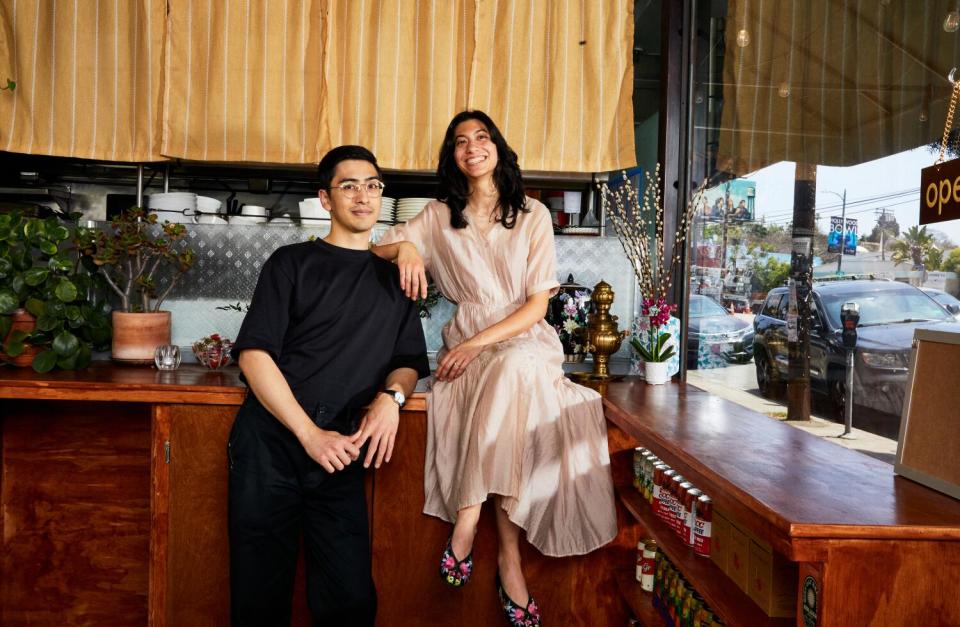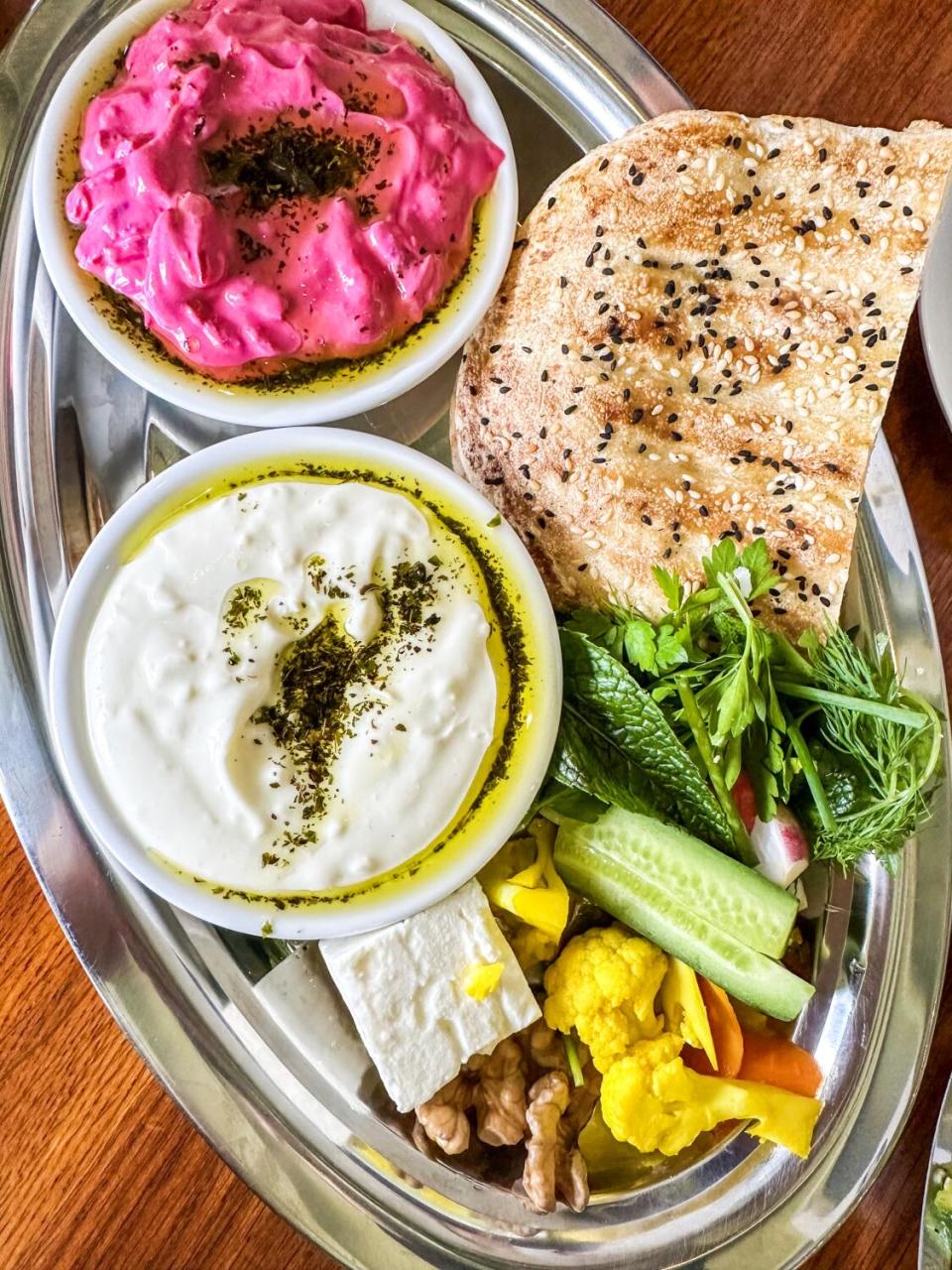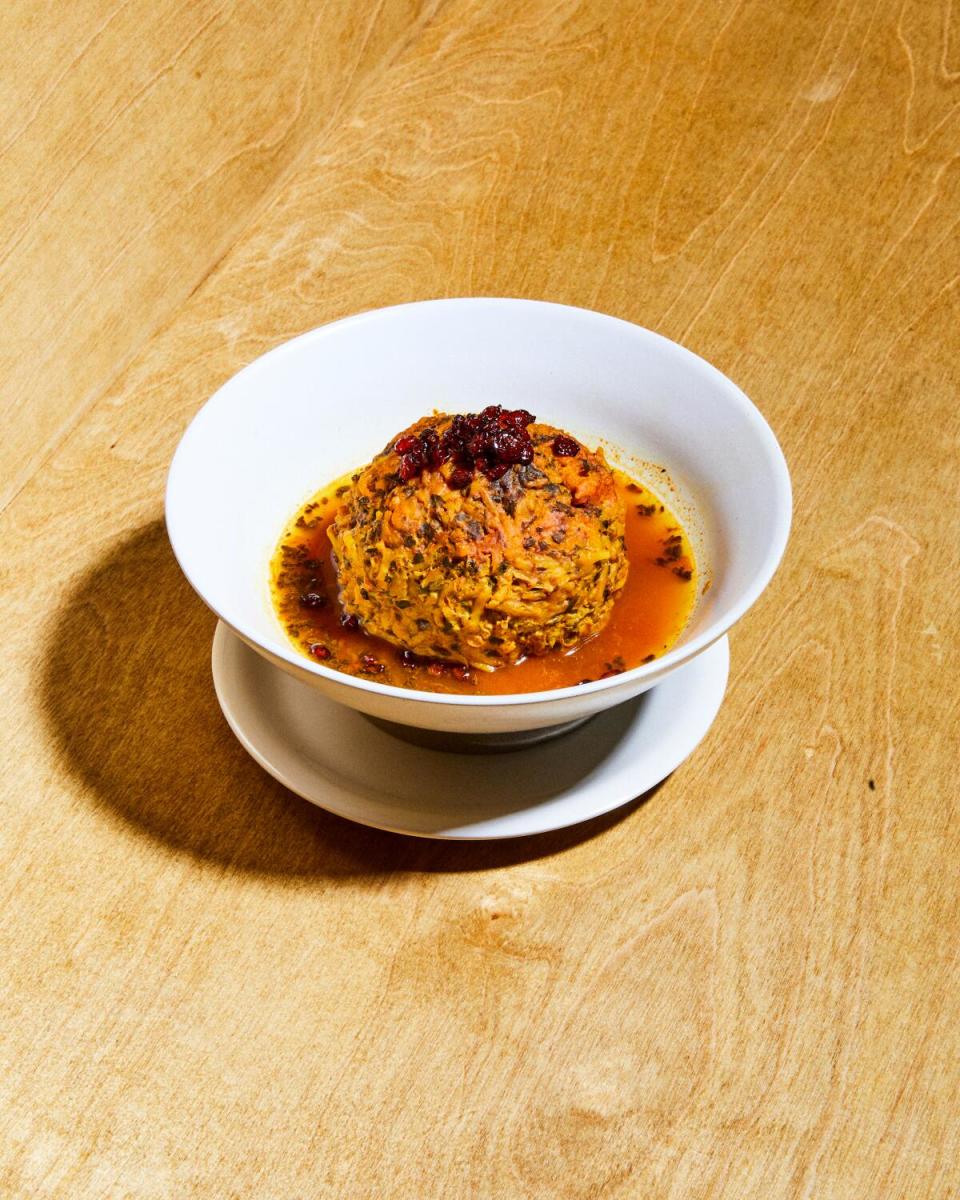Review: A giant meatball is the gateway dish to L.A.'s best new Persian restaurant in years
![LOS ANGELES, CA - JUNE 17: [Cody Ma and Misha Sesar share a few dishes from their Persian Restaurant Azizam] on Monday, June 17, 2024 in Los Angeles, CA. (Ethan Benavidez / For The Times)](https://s.yimg.com/ny/api/res/1.2/1JMqLJ99e9VzoKtRYVPg7A--/YXBwaWQ9aGlnaGxhbmRlcjt3PTEyNDI7aD03NDI-/https://media.zenfs.com/en/la_times_articles_853/148de2cee38f3dac1fb612b121b3fa32)
It’s hard to miss the giant meatball.
Anyone on their way to ordering at the counter inside Azizam, while passing through its patio along Sunset Boulevard in Silver Lake, might instinctively sweep their gaze over the tables already full of Persian dishes. Colors parade on platters as if in competition: pickled cauliflower radiating golden turmeric, pureed beets staining yogurt hot pink, the painterly play of greens among dusky olives, sprinklings of dried mint over soup and bunches of parsley on an appetizer plate.
The kofteh Tabrizi, by contrast, is eye-catching solely for its stature: a stoic orb, just larger than a softball, lolling in a pool of ruddy sauce. Imposing yet alluring, its construction at first glance looks straightforwardly beefy, crowned with dried barberries that shine like a handful of rubies in a caper movie.
Lean in to make out shapes of grains and legumes and squiggly slivers of caramelized onions, and to glimpse flecks of herbs. The closer you look, the more you see.

This can apply to so much on Azizam’s concise menu. It’s cooking easily enjoyed at face value. In its quiet precision, though — the engineered whoosh of fragrances, the yogurt’s specific thickness and tang, the flatbread’s yielding crackle — you can also sense that every recipe leads back to a good story.
The narrative begins when Cody Ma and Misha Sesar met last decade at a party.
Its host, who worked with Ma at Pine & Crane, introduced them knowing that they each had parents who shared Iranian and Chinese heritages. Neither Ma nor Sesar had met anyone before with the same background.
Sesar grew up in Orange County, surrounded by her father’s large family, most of whom had immigrated from Tabriz, an ancient center of the Silk Road trade in northwestern Iran. Ma was raised in Omaha. In 1996 his mother opened a restaurant there, still in operation, called Mediterranean Bistro. Her menu blends likable Levantine mezze (hummus, tabbouleh, baba ghannouj, stuffed grape leaves) with kebabs and other Persian-style recipes she’d learned from her Tehrani mother.
Read more: Review: 10 favorite ways to eat through the wondrous Mercado González
In the pandemic, with Ma sidelined from his restaurant job and Sesar from her career as an art gallery director, they filled time by experimenting with Iranian cuisine. Sesar began baking the crisp-soft, sesame-speckled flatbread called barbari that they usually drove to Irvine to buy. The two of them compared their family’s regional variations on thick sandwiches, and custardy desserts scented with cinnamon or rose water or saffron, and khoresht, generously spiced meat stews that vary to incorporate each season’s fruits and vegetables.
By the following year, in June 2021, the couple had decided to channel their endeavors into a pop-up they called Azizam, a term of affection that translates as “my dear” in Farsi.
I was keen on Azizam right away, particularly for the winking use of the hashtag #notjustkebabs in its early social media posts. In 2019 I had enlightening conversations with Iranian American cookbook authors Andy Baraghani and Naz Deravian about the disparate experiences between meals in Persian households and dining in Persian restaurants.
Family settings often involve dishes that can be exceptionally labor intensive (the mounds of chopped herbs, as one example) or stews so nuanced and subtle they defy professional-kitchen standardization. Most restaurant menus, they agreed, are purposefully designed around crowd-pleasing, fire-kissed kebabs, creamy dips and snowdrifts of seasoned rice heaped on platters.

As a mobile operation, Ma and Sesar were unusually nimble at blurring those lines. Kebabs can be wonderful, and our city with its Iranian community that numbers nearly 140,000 residents, has plenty of institutions devoted to them. Locally, it’s been far rarer outside a home to taste minted celery khoresht, a springtime tonic Ma and Sesar served with either saffron-marinated chicken or fried artichokes. Or to find summery baked eggplant kuku (the Persian frittata prototype), which the pair sliced into wedges and dressed with roasted tomato, garlicky yogurt and basil. Or, when autumn would arrive, the comfort of their chicken braised in sweet spices with butternut squash and plums.
Typically these dishes would arrive flanked with sides familiar to restaurant-goers: dips like masto-o-moussir (yogurt stung with the distinct flavor of dried wild shallots), the crucial piles of rice and Shirazi salad full of chunky-cut tomatoes and cucumbers.
Read more: L.A.’s only Dominican restaurant introduces a family’s legacy of meaty, comforting glories
After honing their culinary aesthetic for nearly three years, Ma and Sesar gave Azizam a stationary home in a space that looks nearly built into the side of a hill. The patio feels somewhere between a sunlit refuge and, in its furthest corners, a bunker. Its snug casualness fits the no-reservations cafe atmosphere — the restaurant is open for dinner and also lunch, an enormous daytime gain for Silver Lake — and the food has enough visual beauty to give the place character.
A mazeh plate sets the tone handsomely. Halved walnuts, a cube of feta, a square of barbari and herbs for nibbling border the spread, which is served with two choices among a half-dozen cold options: olive taut with the tart-sweet taste of pomegranate molasses, Shirazi salad, masto-o-moussir or another meticulously textured yogurt variation, pickles or mirza ghasemi, an eggplant and tomato dip. I’m usually in for all the yogurts, with separate orders of salad and olives.

If I’d had one quibble with Azizam the pop-up, it’s that the occasional sandwiches Ma and Sesar assembled could be unbalanced: heavy on the bread, meager on the fillings.
The issue has been resolved at the restaurant. They’ll likely change eventually, but currently two knockouts vie for attention. Kuku sabzi, a gorgeous egg-bound mulch of herbs and leeks, anchors a meatless stack of tomatoes, cucumbers and radish spread with garlic yogurt. The other one layers kerchiefs of beef tongue (it tastes like pot roast) with tomatoes, yogurt and a brightening spray of fresh herbs. Eastside fans of Attari Sandwich Shop in Westwood, where the beef tongue is a staple, might be satisfying their cravings with a shorter commute.

Even as the weather warms, don’t overlook ash-e-jo, the hearty-sounding soup of grains (predominantly barley), spinach and beans with swirls of fermented whey and mint oil and fried onions as a finishing garnish. I love the look on friends’ faces at their first spoonful, mirroring my own reaction: the disarming, melting lightness and the darting flavors, at turns pleasantly sour and richly herbed.
An entree such as the turmeric-marinated chicken, braised to utter tenderness and served over rice, is one that both Sesar's and Ma’s families cook nearly identically.
The kofteh Tabrizi, which they included in some of Azizam’s earliest menus and remains a marquee dish, more reflects their triumph as collaborators.

Among ground beef the mixture also holds rice, split peas, dried tarragon and summery savory and freshly minced cilantro, parsley and chives. Ma’s grandmother taught him the technique of tossing wads of the kofteh back and forth between the hands to keep the texture delicate and barely self-contained. The center holds a secret: dried apricots, prunes, barberries and walnuts, in the style of Sesar’s family recipes.
They braise the kofteh in the oven (traditionally it’s done on the stove) in a tomato-based sauce electric with Persian dried lime for its distinct, alluring sour notes. True to Ma’s lessons, the sphere is so tender it falls apart with a prod of a fork, tumbling under its complexities and revealing its sweet core.
It’s the centerpiece on nearly every table at Azizam, and its popularity has extra meaning for Ma and Sesar.
Ma’s mother, Shohreh Ma, tried at first to include it on her restaurant’s menu in Nebraska 30 years ago. Kofteh is clearly laborious, and her clientele never quite warmed to the dish, so she stopped making it, and she worried that Ma and Sesar would be repeating her mistake in their efforts.
Learning that it’s a consistent hit has been validating for the kitchen lessons Shohreh and her family passed on to Ma, who says, “She’s always like, this is a dream come true that you’re able to do this.”
For a proud mother, and for L.A.’s Persian dining culture.

This story originally appeared in Los Angeles Times.


